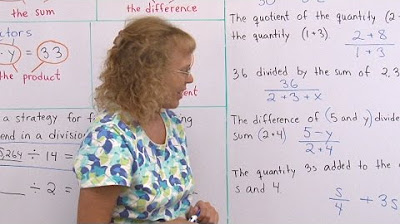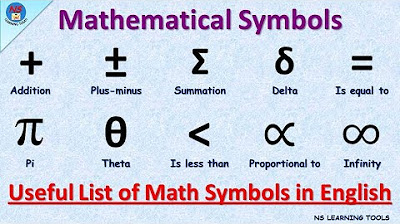Free English Class! Topic: Math! ➗➕➖ (Lesson Only)
TLDRThis English lesson delves into the world of mathematics, highlighting its daily relevance and exploring the language used in math. It covers basic arithmetic, including addition, subtraction, multiplication, and division, and introduces more complex concepts like algebra, geometry, and the use of calculators. The lesson also touches on the historical use of the abacus and the importance of understanding mathematical terminology, providing a comprehensive overview for English learners interested in math.
Takeaways
- 😀 The lesson aims to make math relatable to English learners, regardless of their interest in the subject.
- 📚 There is a difference in terminology between North American and British English, with 'math' being used in the former and 'maths' in the latter.
- 🔢 Mathematics encompasses a wide range of topics, but 'basic arithmetic' specifically refers to addition, subtraction, multiplication, and division.
- ➕ The process of adding numbers together results in a 'sum', as illustrated by the equation 3 + 4 = 7.
- ➖ Subtraction involves taking one number away from another, with the result being called the 'difference', such as in 9 - 3 = 6.
- 🔄 Multiplication is another form of arithmetic, where numbers are combined using the 'times' sign, resulting in a 'product', like 2 x 3 = 6.
- 📉 Division is the process of splitting a number into equal parts, with the result known as the 'quotient', exemplified by 35 ÷ 7 = 5.
- 📈 The script introduces concepts like fractions, percentages, ratios, and decimals, which are essential for understanding more complex math.
- 📊 Algebra and geometry are branches of mathematics that deal with variables and shapes, respectively, and are typically introduced at higher education levels.
- 🔢 The use of calculators, from basic to scientific and graphing calculators, is widespread for solving math problems, but basic arithmetic skills are still encouraged.
- 📈 The importance of understanding and using mathematical symbols, such as greater than (>) and less than (<), is highlighted for comparing values.
- 📈 The script also touches on historical tools like the abacus and the modern use of graphs to visualize mathematical equations.
Q & A
What is the main topic of this English lesson?
-The main topic of this English lesson is math, focusing on the vocabulary and concepts used in mathematics in an English context.
Why might this lesson be beneficial for someone who doesn't like math?
-This lesson could be beneficial for someone who doesn't like math because it presents mathematical concepts in an English language context, potentially making the subject more approachable and relevant to their interests.
What is the difference between 'math' and 'maths'?
-The difference between 'math' and 'maths' is regional. 'Math' is the short form used in North American English, while 'maths' is commonly used in British English.
What are the four basic operations of arithmetic mentioned in the script?
-The four basic operations of arithmetic mentioned are addition, subtraction, multiplication, and division.
What is the term used to describe the answer to an addition equation?
-The term used to describe the answer to an addition equation is the 'sum'.
What is the term used for the result of a multiplication equation?
-The term used for the result of a multiplication equation is the 'product'.
What is the term used to describe the process of finding an unknown in an equation?
-The term used to describe the process of finding an unknown in an equation is 'solving the equation'.
What is the term used for a mathematical statement that asserts the equality of two expressions?
-The term used for a mathematical statement that asserts the equality of two expressions is an 'equation'.
What is the term used for a mathematical concept where one quantity is a specified number of times another?
-The term used for a mathematical concept where one quantity is a specified number of times another is a 'ratio'.
What is the term used for a mathematical concept that involves a number raised to a power?
-The term used for a mathematical concept that involves a number raised to a power is an 'exponent'.
Why might the speaker suggest that students rely too much on calculators?
-The speaker suggests that students rely too much on calculators because they believe students should know how to do basic arithmetic mentally and have a strong foundation in their times tables.
What is the historical significance of the abacus mentioned in the script?
-The abacus, mentioned in the script, is a historical counting tool used for centuries to perform basic arithmetic operations like addition and subtraction.
What is the difference between a regular calculator, a scientific calculator, and a graphing calculator?
-A regular calculator performs basic arithmetic operations. A scientific calculator includes functions like sine, cosine, and tangent, as well as exponents and square roots. A graphing calculator can perform all the functions of a scientific calculator and additionally graph equations.
Outlines
📚 Introduction to the English Lesson on Math
The speaker introduces an English lesson focused on math, acknowledging that people have different levels of interest in the subject. They emphasize that math is a part of daily life, whether it's calculating change or determining quantities for purchases. The speaker admits that the lesson will contain more numbers and less imagery than usual. They also discuss the linguistic difference between 'math' in North American English and 'maths' in British English, explaining that 'mathematics' is the formal term but 'math' is the common abbreviation used in North America.
🔢 Basic Arithmetic and Terminology
This paragraph delves into the fundamentals of arithmetic, including addition, subtraction, multiplication, and division. The speaker explains the use of plus signs, equal signs, and the terms 'sum' and 'difference' in the context of these operations. They also touch on the importance of these basic skills in school and everyday life, such as in financial transactions. The paragraph highlights the English language conventions used when discussing mathematical equations and operations.
📈 Advanced Math Concepts and Their Applications
The speaker transitions to more advanced mathematical concepts, including long division, fractions, percentages, ratios, and decimals. They provide examples of how these concepts are used in real-life situations, such as measuring lengths in feet and inches or calculating percentages for test scores. The paragraph also introduces the idea of exponents and explains how they are used to represent repeated multiplication. The speaker shares personal anecdotes about the use of calculators and the importance of understanding basic arithmetic without relying solely on these tools.
📉 Algebra, Geometry, and the Importance of Variables
This section introduces higher-level math disciplines such as algebra and geometry. Algebra is described as the study of variables and equations, where solving for unknowns is a key skill. Geometry is portrayed as the study of shapes, including concepts like perimeter, area, diameter, and radius. The speaker also discusses the use of greater than and less than signs, providing a mnemonic to remember their orientation based on an alligator eating the larger number.
📊 Calculators, Graphs, and the Evolution of Math Tools
The final paragraph discusses the role of calculators in modern mathematics, from basic models to scientific and graphing calculators. The speaker expresses a concern that students may rely too heavily on calculators and neglect learning basic arithmetic skills. They also mention the historical use of the abacus as an early calculating tool. The paragraph concludes with an explanation of graphs as a way to visually represent mathematical relationships and equations in two dimensions.
Mindmap
Keywords
💡Mathematics
💡Arithmetic
💡Addition
💡Subtraction
💡Multiplication
💡Division
💡Fractions
💡Percent
💡Ratio
💡Decimals
💡Algebra
💡Geometry
💡Variables
💡Graphing
💡Calculator
Highlights
Introduction to an English lesson about math, discussing its relevance regardless of personal preferences.
Explanation of the difference between 'math' in North American English and 'maths' in British English.
Basic arithmetic is differentiated from the broader term 'mathematics'.
The four fundamental operations of arithmetic: addition, subtraction, multiplication, and division.
The use of specific language when describing mathematical operations and equations.
Describing the process and terminology of addition, including the use of 'plus' and 'sum'.
Subtraction explained, including the concept of 'minus', 'takeaway', and 'difference'.
Multiplication is introduced with the terms 'times', 'multiply', and 'product'.
Division is defined, with an explanation of 'divides', 'quotient', and the process of dividing.
Long division is introduced, with a description of the process and its components.
The concept of equations, including the use of the equal sign, is explained.
Fractions are introduced with examples and their practical applications.
The concept of percentages is explained, including its relation to the number 100.
Ratios are introduced, with examples of their use in real-life situations.
Decimals are explained, with a comparison to fractions and their representation.
Exponents are introduced, explaining how they represent repeated multiplication.
The impact of removing pennies in Canada on rounding transactions is discussed.
The concept of averages is explained, with an example of calculating the mean.
Algebra is introduced, explaining its focus on variables and equations.
Geometry is introduced, focusing on the study of shapes and their properties.
The use of greater than and less than signs is explained, with a mnemonic for remembering their orientation.
The role of calculators in mathematics, including different types and their uses.
The historical use of the abacus for mathematical calculations.
The use of graphs in higher-level mathematics to visualize equations and data.
Transcripts
Browse More Related Video

Maths Symbols & Equations - English Vocabulary | Maths Vocabulary | Math or Maths | Basic Math

MATH & GEOMETRY Vocabulary and Terminology in English

Terminology for the basic operations and writing algebraic expressions from words

Math Videos: How To Learn Basic Arithmetic Fast - Online Tutorial Lessons

List of Mathematical Symbols in English | Math Symbols Vocabulary | 65 Mathematics Symbols

List of Mathematical Symbols in English | Math Symbols Vocabulary Words
5.0 / 5 (0 votes)
Thanks for rating: